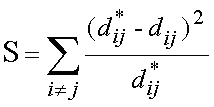|
www.tlab.it
Multidimensional Scaling
(MDS)
MDS is a set of data
analysis techniques that allow us to analyse similarity matrices in
order to provide a visual representation of the relationships among
the data within a space of reduced dimensions.
T-LAB uses a type of MDS (Sammon's
method) in order to represent the relationships among the lexical
units or among the thematic nuclei (see Co-Word Analysis and Modeling of Emerging Themes).
The input tables are constituted by square matrices which
contain proximity values (dissimilarities) derived from the
calculation of an association
index.
The results obtained, like those of the correspondence analysis, allow us to interpret
both the relationships between the "objects" and the dimensions
that organize the space in which they are represented.
The degree of correspondence between the distances
among points implied by the MDS map and the matrix input is
measured (inversely) by a Stress
function. The lesser the stress value (e.g. < 0.10), the greater
the goodness of the obtained adjustment.
The stress formula
(Sammon's method) is the following:

Where  stands for the
distance between two points (ij) within the input matrix and stands for the
distance between two points (ij) within the input matrix and
 stands
for the distance between the same points (ij) within Sammon's
map. stands
for the distance between the same points (ij) within Sammon's
map.
|